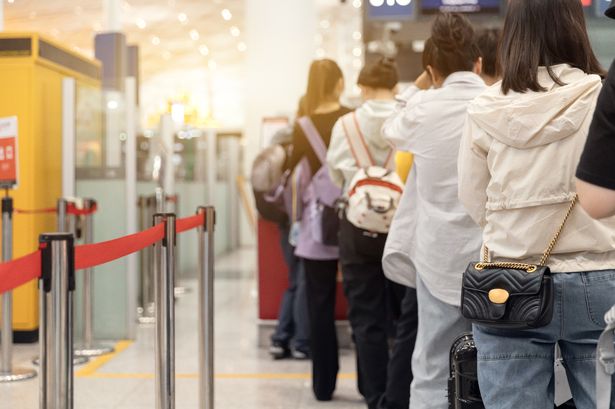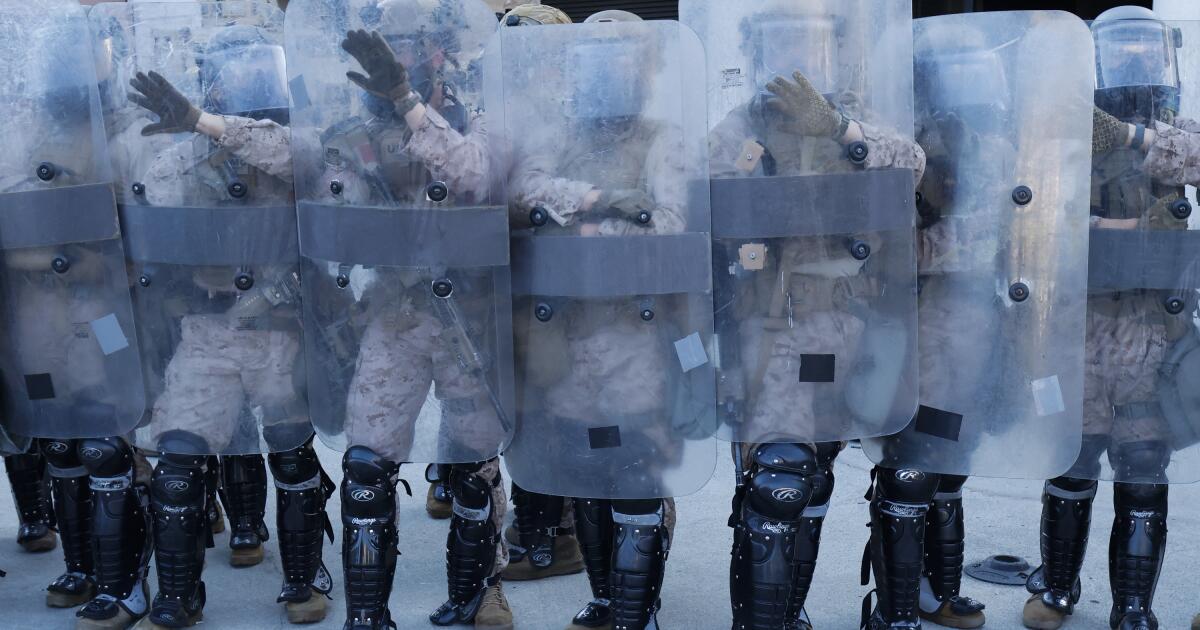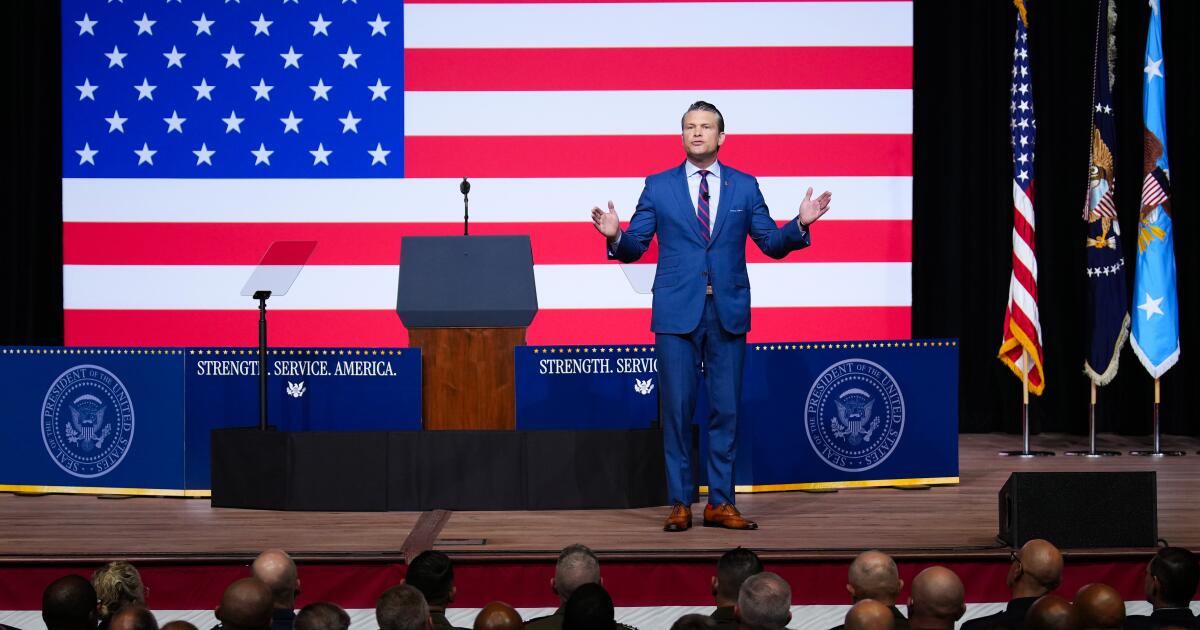President Trump warned the country’s top ranking military officials Tuesday that they could be headed to “war” with U.S. citizens, signaling a major escalation in the ongoing legal battle over his authority to deploy soldiers to police American streets.
“What they’ve done to San Francisco, Chicago, New York, Los Angeles — they’re very unsafe places, and we’re going to straighten them out one-by-one,” Trump said in an address to top brass in Quantico, Va. “That’s a war too. It’s a war from within.”
Commanders should use American cities as “training grounds,” the president said.
Trump’s words provoked instant pushback. Oregon has already filed a legal challenge, and experts expressed concern that what the president described is against the law.
“He is suggesting that they learn how to become warriors in American cities,” said Daniel C. Schwartz, former general counsel at the National Security Agency, who heads the legal team at National Security Leaders for America. “That should scare everybody. It’s also boldly illegal.”
The use of soldiers to assist with federal immigration raids and crowd control at protests and otherwise enforce civilian laws has been a point of contention with big city mayors and blue state governors for months, beginning with the deployment of thousands of federalized National Guard troops and hundreds of Marines to Los Angeles in early June.
That deployment was illegal, a federal judge ruled last month. In a scorching 52-page decision, U.S. District Court Judge Charles R. Breyer barred soldiers under Trump’s command from carrying out law enforcement duties across California, warning of a “national police force with the President as its chief.”
Yet hundreds of troops remained on the streets of Los Angeles while the matter was under litigation. With the case still moving through the 9th Circuit Court of Appeals, hundreds more are now set to arrive in Portland, Ore., with another hundred reportedly enroute to Chicago — all over the objections of state and local leaders.
“Isolated threats to federal property should not be enough to warrant this kind of response,” said Eric J. Segall, a professor at Georgia State University College of Law. “The threat has to be really serious, and I don’t think the Trump administration has made that case.”
Others agreed.
“I’m tremendously worried,” said Erwin Chemerinsky, dean of the UC Berkeley School of Law. “Using the military for domestic law enforcement is something that’s characteristic of authoritarian regimes.”
Oregon’s attorney general filed a lawsuit Monday alleging the president had applied a “baseless, wildly hyperbolic pretext” to send in the troops. Officials in Illinois, where the Trump administration has made Chicago a focal point of immigration enforcement, are also poised to file a challenge.
Although the facts on the ground are different legally, the Oregon suit is a near copy-paste of the California battle making its way through the courts, experts said.
“That’s exactly the model that they’re following,” said Carl Tobias, a professor at the University of Richmond School of Law.
Unlike the controversial decision to send National Guard troops to Washington, D.C., in August, the Los Angeles and Portland deployments have relied on an esoteric subsection of the law, which allows the president to federalize troops over the objection of state governments in certain limited cases.
California’s challenge to those justifications has so far floundered in court, with the 9th Circuit finding in June that judges must be “highly deferential” to the president’s interpretation of facts on the ground. That case is under review by a larger panel of judges.
In a memo filed Monday, California Deputy Solicitor General Christopher D. Hu warned that the decision had emboldened the administration to deploy troops elsewhere, citing Portland as an example.
“Defendants apparently believe that the June 7 memorandum — issued in response to events in Los Angeles — indefinitely authorizes the deployment of National Guard troops anywhere in the country, for virtually any reason,” Hu wrote. “It is time to end this unprecedented experiment in militarized law enforcement and conscription of state National Guard troops outside the narrow conditions allowed by Congress.”
Experts warn the obscure 19th century law at the heart of the debate is vague and “full of loopholes,” worrying some who see repeated deployment as a slippery slope to widespread, long-term military occupations.
“That has not been our experience at least since the Civil War,” Schwartz said. “If we become accustomed to seeing armed uniformed service personnel in our cities, we risk not objecting to it, and when we stop objecting to it, it becomes a norm.”
The joint address to military leaders in Virginia on Tuesday further stoked those fears.
“We’re under invasion from within,” the president admonished generals and admirals gathered in the auditorium. “No different from a foreign enemy, but more difficult in many ways because they don’t wear uniforms.”
He touted the move in August to create a “quick reaction force” to “quell civil disturbances” — a decree folded into his executive order expanding the D.C. troop deployment.
“George Washington, Abraham Lincoln, Grover Cleveland, George Bush and others all used the armed forces to keep domestic order and peace,” Trump said. “Now they like to say, oh, you’re not allowed to use the military.”
Those historic cases have some important differences with 2025, experts say.
When President Cleveland sent troops to break up a railroad strike and tamp down mob violence against Chinese immigrants, he invoked the Insurrection Act. So did 15 other presidents, including Lincoln, Franklin D. Roosevelt, Dwight D. Eisenhower, John F. Kennedy and George H.W. Bush.
Experts stress that Trump has pointedly not used the act, despite name-checking it often in his first term.
Defense Secretary Pete Hegseth on Tuesday largely avoided the theme of “enemies within,” instead extolling the “warrior ethos” at the heart of his military reform project. He railed against what he saw as the corrupted culture of the modern military — as well as its aesthetic shortcomings.
“It’s tiring to look out at combat formations and see fat troops,” Hegseth said. “It’s completely unacceptable to see fat generals and admirals in the halls of the Pentagon. It’s a bad look.”
As deployments multiply across the country, experts said they were watching what the appellate division and ultimately the Supreme Court will decide.
“It will be a test for the Supreme Court,” Schwartz said. “Whether they are willing to continue to allow this president to do whatever he wants to do in clear violation of constitutional principles, or whether they will restrain him.”







